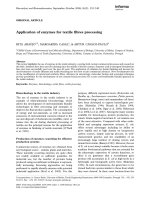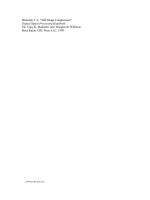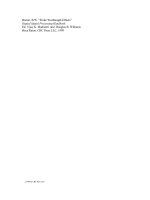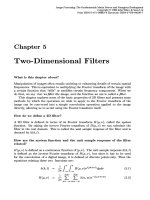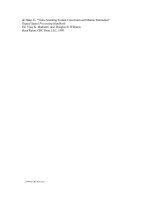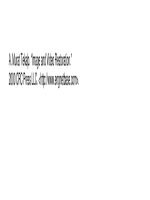- Trang chủ >>
- Khoa Học Tự Nhiên >>
- Vật lý
aster mineral index processing
Bạn đang xem bản rút gọn của tài liệu. Xem và tải ngay bản đầy đủ của tài liệu tại đây (1.45 MB, 37 trang )
ASTER Mineral Index Processing
Manual
Compiled by Aleks Kalinowski
and Simon Oliver
Remote Sensing Applications
Geoscience Australia
October 2004
Contents
i.
Introduction 2
ii. Useful References
Processing steps (for L1B scenes)
1.
Obtaining ASTER scenes 4
2.
Crosstalk Correction 4
3.
Importing into ER Mapper 6
4.
Image Rectification 11
5.
Radiance Calibration 13
6.
Dark Pixel Correction 16
7. Registering ASTER images to Landsat 18
8.
Tips 21
9.
ASTER Band Ratios 22
Some Useful Hints for Beginners
10.
Changing Format of PIMA Spectra Using SPECWIN 24
11.
Creating a Spectral Library in ENVI 27
12.
Using ENVI's Spectral Analyst to Determine Mineralogy 30
13.
Resampling Library Spectra to ASTER Band Resolution 31
14.
Minimum Noise Fraction Images 32
15.
Principal Components Images 34
16.
Decorellation Stretch Images 36
1
i. Introduction
ASTER is the Advanced Spaceborne Thermal Emission and Reflection Radiometer, a multi-
spectral sensor onboard one of NASA’s Earth Observing System satellites, Terra, which was
launched in 1999. ASTER sensors measure reflected and emitted electromagnetic radiation
from Earth’s surface and atmosphere in 14 channels (or bands). There are three groups of
channels: three recording visible and near infrared radiation (VNIR), at a spatial resolution of
15m; six recording portions of shortwave infrared radiation (SWIR) at a spatial resolution of
30m; and five recording thermal infrared radiation (TIR) at a resolution of 90m. The higher
spectral resolution of ASTER (compared to Landsat, for example - Fig.1) especially in the
shortwave infrared region of the electromagnetic spectrum makes it possible to identify
minerals and mineral groups such as clays, carbonates, silica, iron-oxides and other
silicates. An additional backward-looking band in the VNIR makes it possible to construct
digital elevation models from bands 3 and 3b. ASTER swath width is 60km (each scene is 60
x 60km) which makes it useful for regional mapping.
Figure 1. Distribution of ASTER and Landsat channels with respect to the electromagnetic spectrum.
There are a few things to note when using ASTER imagery for regional mineralogical
mapping. Firstly, cloud cover, vegetation and atmospheric effects can severely mask or alter
surface signals. Secondly, bands and band ratios do not indicate the occurrence of a mineral
with absolute certainty or with any idea of quantity, so ground truthing and setting
appropriate thresholds is essential. Thirdly, every terrain is different, so ratios which work in
some areas for a particular mineral or assemblage may not show the same thing elsewhere.
As a result of these factors, it is important not to look at ASTER images in isolation from
other data. If possible, datasets such as geology and structural maps, geochemistry, PIMA
analyses (ground truthing), radiometrics, and any other available data should be used in
conjunction with ASTER for best results.
2
The processing steps described in the first part of this manual are relevant only to ASTER
level 1B scenes. Level 1A scenes (in a less processed form) must be imported using image
processing software such as Rastus.
ii. Useful References
For tutorials on remote sensing and image processing:
• Canada Centre for Remote Sensing tutorial
• NASA tutorial
• List of online tutorial sites
• ENVI hyperspectral analysis tutorial
For more general information on ASTER:
• ERSDAC
• NASA TERRA website
• NASA ASTER website
• CSIRO
Publications on ASTER and relevant authors:
• NASA reference list
• Hewson, R. (CSIRO).
• Rowan, L. (USGS), Abrams, Mars
3
1. Obtaining ASTER scenes
1) Identify and define the area you want ASTER scenes for (either as a box or a point of
interest in Lat / Long).
2) Go to the ACRES Digital Catalogue website (
3) You will need to obtain a login - follow the instructions.
4) On the website you will find the document "Procedures for accessing ASTER satellite
image data on ACRES Digital Catalogue". This contains complete instructions on
how to find your data. The ASTER scenes are stored on DVD at Geoscience
Australia - contact an ACRES or RSA person to gain access to the DVDs.
5) Copy your selected scene(s) to your hard drive or CD (generally it is better to have
the scenes on your hard drive to speed up processing).
2. Crosstalk Correction
Crosstalk is an effect in ASTER imagery caused by signal leakage from band 4 into adjacent
bands 5 and 9.
"The primary band causing most of the cross talk problem is band 4. What they believe is
happening is that some of the incident photons onto the band 4 detector plane are reflected
(not a surprise since even a perfect, single detector can reflect as much as 30% of the
incident light). The problem is that there are no baffles or other structures blocking light from
band 4 bouncing around to the detectors for the other bands. Basically, the detectors are
arranged in a rectangular geometry and the top of the rectangle contains all of the filters for
all of the bands. The bottom contains the detectors for all bands (and all of the detectors
have the same spectral response). Once an incident photon enters, it is basically trapped
until some detector collects it. If the band 5 detector gets a photon through the band 4 filter,
cross talk occurs.
The basic problem is that the solar output in band 4 is considerably higher than the other
SWIR bands. Hence, even a small number of band 4 photons leaking out can have a big
effect in the other bands. The effect is largest in bands 5 and 9 because those detectors are
physically the closest to the band 4 detectors. The correction at this point is assumed to be
an offset based on the pixels location in the scene. Essentially, a Gaussian distribution is
drawn around the pixel of interest in band 9 (for example). The band 4 scene is then
examined to determine the radiance of each pixel within the Gaussian, and then the
contribution due to cross talk from each of these pixels is determined by the radiance of the
pixel and the Gaussian value acting as weighting function." (Rob Hewson, MMTG,
Exploration and Mining, CSIRO. 22nd ASTER Science Meeting,
(
1) There is a handy tool that automatically corrects your scene for crosstalk. Download
and install the ERSDAC Crosstalk 3 tool from
/>ss.html . You will need a zip file extractor that can handle Japanese versions (e.g.
Power Archiver 2001 or later).
2) The tool comes with instructions in PDF, but you may have to download the
Japanese Language Package for Acrobat Reader from the Adobe site if the
document isn't opening properly.
3) Navigate to Start menu → Programs → Crosstalk3 → Data IO Setup. The dialog box
below opens.
4
4) On the left of the dialog box, select your (uncorrected) input image(s) by clicking on
the
button to the text field. Only HDF or DAT file formats are accepted. A
corresponding output file name will appear on the right (it is the same name but with
"_chg" appended to the name). You can process up to 10 images at a time.
5) Go to File → Start Process to correct the images. Close the dialog when finished.
Back to contents
5
3. Importing Images Into ER Mapper
A raw ASTER dataset contains all 14 bands. However, ASTER data consists of three types
of datasets, each with a different spatial resolution, so each must be treated independently.
The three datasets are VNIR (Visible and Near Infrared, bands 1-3), SWIR (Short-Wave
Infrared, bands 4-9) and TIR (Thermal Infrared, bands 10-14). They have spatial resolutions
of 15, 30 and 90m respectively. Two ways of importing ASTER datasets into ER Mapper are
described below. The first method describes how to manually import the data, while the
second makes use of the HDF Import Wizard. It is worthwhile going through the process
manually at least once so that you know what is being done to the data every step of the
way.
Method 1: Manually importing the dataset
A. Construct the VNIR dataset
1) Start ER Mapper and open the algorithm window with a new image window. You
should have one Pseudo layer in the empty algorithm.
2) Load your crosstalk-corrected HDF file into the pseudo layer.
3) Duplicate the layer twice (total of three layers).
4) Select VNIR:band 1 for layer 1 and rename the layer to reflect the original band
number (e.g. B1).
5) Select VNIR:band 2 for layer 2 and VNIR:band 3 (3N not 3B) for layer 3 and rename
the layers.
6) Save the dataset as an ER Mapper raster dataset (.ers). The dataset should be
saved as an 8-bit unsigned integer with 15m pixels (pixel width & height). Make sure
output transforms are deleted and be sure to give the file a meaningful name, for
example, reflecting the level of processing that has been applied.
6
B. Construct the SWIR dataset
1) Open a new algorithm window (or a new image window). You should have one
Pseudo layer in the empty algorithm.
2) Load your crosstalk-corrected HDF file into the pseudo layer.
3) Duplicate the layer five times (total of six layers).
4) Select SWIR: band 4 for layer 1 and rename the layer to reflect the original band
number (e.g. B4). NB: Be careful not to load band 3B into band 1 of your algorithm
(the real SWIR band 4 is actually called band 5 in the HDF dataset).
5) Select SWIR: band 5 for layer 2 and repeat for the other layers up to band 9.
Rename the layers.
6) Save the dataset as an ER Mapper raster dataset (.ers). The dataset should be
saved as an 8-bit unsigned integer with 30m pixels. Ensure output transforms are
deleted.
C. Construct the TIR raster dataset
1) Open a new algorithm window (or a new image window). You should have one
Pseudo layer in the empty algorithm.
2) Load your crosstalk-corrected HDF file into the pseudo layer.
3) Duplicate the layer four times (total of five layers).
4) Select TIR: band 10 for layer 1 and rename the layer to reflect the original band
number (e.g. B10).
5) Select TIR: band 11 for layer 2 and repeat for the other layers up to band 14.
Rename the layers.
6) Save the dataset as an ER Mapper raster dataset (.ers). This dataset should be
saved as 16-bit unsigned integer with 90m pixels. Ensure output transforms are
deleted.
7
Method 2: Using HDF Import Wizard
The HDF Import Wizard allows you to convert ASTER HDF data to native ER Mapper format.
This tool allows you to import the dataset at different spatial resolutions, for example,
importing VNIR data at 30m instead of 15m, and combining bands with different spatial
resolutions (Note: You can also do this manually using the algorithm window).
1) You can start the HDF Import Wizard from either the Wizards or Batch Processing
toolbar (to add a toolbar to the main menu, go to Toolbars → tick Wizards or Batch
Processing). Click the
button. The HDF Import Wizard appears.
2) Select whether you want to import one or multiple files and click Next.
3) On the next panel, select your raw (crosstalk corrected) ASTER HDF input file and
tick the box next to Produce .ers raster image. Type in a name for your output dataset
and click Next.
8
4)
e box.
Click
5)
x - the wizard will automatically choose the
cell size fro
On the next panel, you have the option of rotating the scene to true north (accounting
for the rotation of the image due to the orientation of the satellite as it makes its
pass). You can use this option or manually rotate the image later. Here you also have
the option of setting a null value for null cells in the image. Type "0" into the Null
Value text field if it isn't automatically there, and tick the Use a null cell valu
Next.
The next panel allows you to set cell attributes. Most importantly, it allows you to set
the output cell size, which is chiefly useful if you are going to import bands with
different resolutions into one dataset. To do this, tick the Custom cell size box. For
example, if you are importing the VNIR and SWIR bands together, you can set the
cell size to 15m or 30m for all bands. You then need to choose a resampling method
(cubic is recommended). If you are importing bands with the same spatial resolution
then don’t check the Custom cell size bo
m the metadata. Click Next.
9
6) The next panel is where you choose the bands you want to include in the final raster
image. You can either enter the band numbers or select them from the list (click the
button on the right). Click Next.
7) The final panel and a batch status window appear. Check the batch status window to
see what is being done to the image. Click Finish when the process has finished. You
can now go to Step 5 - Radiance Calibration if you rotated your image to true north,
or go on to Step 4 - Image Rectification if you haven't rotated your image yet.
A disadvantage of using this wizard is that you can't set the method by which the dataset is
saved (i.e. 8-bit, 4-byte etc.). It does save a bit of time but doing the same process manually
is not particularly difficult or time consuming and therefore could be a better option.
Back to contents
10
4. Image Rotation
At the moment the images you have loaded are in satellite orientation, i.e. they are rotated
with respect to the surface because the satellite does not travel exactly N-S on its passes.
The image must be therefore be rotated back into map orientation (it is already projected,
generally in WGS84 and UTM). You need to find what angle the image must be rotated
through before using the Geocoding and Orthocorrection Wizard to rotate the image. (Note:
if you used the HDF Import Wizard to convert your HDF files to ER Mapper format and you
have already rotated your datasets then you can skip this step.)
1) Go to File → Open (or press the button in the main toolbar).
2) Highlight the VNIR dataset you made in the previous section but don't open it.
3) Click on the Info… button - a new window will pop up with some metadata about the
image (see below).
4) Find Rotation in the list and take note of the angle. Close all of the windows.
5) From the Process menu on the main toolbar open the Geocoding Wizard. The
geocoding dialog box opens with several tabs (see below).
6) Click on the first tab, Start, if it isn’t already selected. Select an Input file and set the
Geocoding Type to Rotation.
7) Click on the second tab, Rotation Setup. Here you will need the rotation angle you
noted earlier. Type the rotation angle into the text box but multiply it by -1 (i.e. if you
originally had a positive rotation angle, now it will be negative and vice versa). This is
to make sure the image is rotated in the correct direction.
8) Click on the final, Rectify tab. Select a meaningful output filename and pixel size (by
default the pixel size should already be set to be the same as your input dataset).
Cubic Convolution is the recommended Resampling method.
11
9) Click the Save File and Start Rectification button.
10) Repeat the process for the SWIR and TIR datasets (the rotation angle will be the
same as your datasets came from one original dataset).
NB: This process is not necessary if your rotation angle is originally '0'. This happens for
example when you've processed the image from Level 1A to Level 1B using Rastus and
ENVI.
Tip. Occasionally, after rotating your dataset back to zero, there is still a tiny rotation angle in
the metadata of the dataset which you can't see (e.g. 0.0000001). This isn't a problem until
you want to use the dataset in other software packages, such as ENVI, when the rotation
angle prevents the software from reading the projection information correctly. To fix this
problem, go to File → Open → Info… → Edit → Coord Space → Type "0" in the Rotation
field (even if it seems to say "0" already). This will get rid of any tiny fractions of a rotation
angle that might be there. It will not affect your dataset. Make sure you save changes.
Back to contents
12
5. Radiance Calibration
Radiance calibration is a process of rescaling the digital values to observed top of
atmosphere radiance values. Scaling the sensor signal to 8-bit data is important for reducing
information loss. Each ASTER HDF dataset contains scaling values (unit conversion factors
→ UCF) which can be applied using the ER Mapper formula tool and the formula
(Input1 - 1)
×
unit conversion factor. To retrieve the UCF it is necessary to first download the
ASTER Data Opener, a tool which allows you to see the dataset's metadata.
1) Download the ASTER Data Opener from the website
/>ss.html
2) Start the data opener (the executable). In the dialog box, click the Ref button to
choose a dataset (you must set file type to "all files" to see HDF format). You will see
some information about the scene, as shown below.
3) Click the Details button to obtain a more complete version of the metadata. About
halfway down the page you will see Unit Conversion Coefficients listed for each band.
The scaling factor you will use is the first (positive) number for each band.
13
4) Open a new image window and the algorithm window.
5) Load your VNIR rectified dataset into the algorithm and assign each band to a new
layer (layer1 = band1, layer2 = band2 etc.). Rename each layer to represent the
original data band (B1, B2, B3).
6) Select the first layer and open the formula editor.
14
7) Type in the formula (Input1 - 1)
×
UCF (in this case the UCF for VNIR:band 1 is
0.676). Press Apply Changes. Repeat this process for every band in the algorithm,
inserting the appropriate unit conversion factor each time.
Tip: In the algorithm window, load the dataset into one layer. Type in the formula in the
formula editor. Duplicate the layer, choose appropriate bands for each layer and rename the
layers as required. Finally, go to the formula editor for the duplicated layers and edit the UCF
to correspond with the band in that layer. This saves you typing out the formula many times.
8) When finished, save the image as a raster dataset. This time, save it as a 4-byte real
image. This is to preserve the original data integrity especially given radiance
decreases with increasing wavelength (and band number). The pixel size remains 15,
30 or 90m depending on the dataset. Ensure the Delete Transform button is checked.
9) Repeat the process for the SWIR and TIR rectified datasets.
Back to contents
15
6. Dark Pixel Correction
Dark pixel correction is a simple method used to account for the effect of atmosphere on
image radiance, related to additive scattering contributions (there are also multiplicative
transmission effects which won't be corrected by this). This is a statistical method whereby
the minimum value for each dataset is subtracted from the data. This minimum value is
taken to represent / approximate the effect of atmosphere.
1) Load your radiance-corrected dataset from the previous section into a new algorithm
window. Again, assign each band to a different layer and rename the layers
according to the original bands of the dataset.
2) On the main toolbar, navigate to Process → Calculate statistics. In the dialog box,
select the dataset you want to calculate statistics on (the one you've just loaded into
the algorithm window) and set Subsampling Interval to 1. Just to be safe, you can
check the Force recalculate statistics box. Press OK.
3) Once ER Mapper has finished calculating statistics, you can close the statistics
windows (or view the statistics and determine the minimum value for each band in the
dataset).
4) Select the first band in the algorithm and open the formula editor. Type in the formula
I1 - RMIN(,R1,I1). RMIN gives the minimum value for a particular band; R1 specifies
the region of interest (in this case, the whole scene) and I1 specifies the input band.
Do this for each band.
16
Tip: In the algorithm window, load the dataset into one layer. Type in the formula in the
formula editor. Now duplicate the layer, choose appropriate bands for each layer and
rename the layers as required. This saves you typing out the formula many times.
5) Save the dataset as an ER Mapper Virtual Dataset (put "VDS" in the filename so you
can distinguish it from real datasets easily). The virtual dataset is really an algorithm
that is saved to look like a dataset, but it actually references the original dataset(s) (in
this case, the file you just created references your radiance-calibrated dataset, so any
changes to that dataset will also be reflected in the VDS). Alternatively, save it as a 4-
byte real dataset for future work. Ensure rotation is "0" in the header file, else there
could be problems importing the image into ENVI (see the Tips section at the back of
this manual).
6) Repeat this process for your other radiance-corrected datasets (SWIR and TIR).
Back to contents
17
7. Registering ASTER image to Landsat pan image
Rotating ASTER scenes (as described in previous steps) puts the data in the correct
orientation but not necessarily the correct position relative to the ground or to other ASTER
scenes or bands. One way of correctly rectifying the ASTER scene is to register it to the
Landsat pan mosaic image of Australia. The Landsat pan mosaic covers the entire continent
and has been registered to differential GPS points around Australia. As such, it is accurately
registered relative to the ground. Because it has a resolution of 12.5m, it is accurate enough
to be used as a basis for registering other types of remotely sensed data such as ASTER.
The visible bands, having pixels closest in size to the Landsat bands, will be most obviously
affected by displacement and will need the largest block shift. The SWIR bands, having
pixels twice as large, will be affected but only half as much as the VNIR bands; and the TIR
bands, with pixels 6 times the size of the VNIR bands, must be adjusted by 1/6 of the shift
experienced by the VNIR (which means they rarely need to be shifted). Normally the
displacement between the Landsat image and the VNIR ASTER image will be between 0 to
10 pixels (E-W and/or N-S).
1) Open a new algorithm and image window.
2) Change the colour mode to red-green-blue and delete the blue layer.
3) Open Band 3 of the VNIR ASTER image into the red layer only and adjust the
transforms (or use the shortcut Refresh image with 99% clip
button).
4) Open the Landsat image: O:\Mount_Isa_Working\ETM_pan_mosaic_DN.ers (or
equivalent reference image) into the green layer only and adjust the transform.
5) With the two layers displayed together, zoom in and pan around the image and
identify areas with misaligned red and green pixels. These are areas that show how
much the ASTER image is displaced from the Landsat image. Good areas to look at
are roads, airstrips, and road intersections; bad areas are water, rivers, lakes,
because water levels are prone to change, and the images were almost certainly
taken at different times and seasons. Ignore clouds (red). Turn off the smoothing
option to better see individual pixels.
6) Zoom in on a feature where the red and green pixels are not aligned, like a road
(below left). As you can see, the road that appears in the red image is offset to the
left from the green. Decide whether the feature is displaced to the east or west, north
or south relative to Landsat, and by how many pixels (zoom in to do this). The feature
will appear yellow when the two datasets are exactly aligned (red + green = yellow)
(below right).
18
7) In the algorithm window, right-click on the red layer (containing the ASTER image)
and select Properties from the bottom of the list.
8) In the Dataset Information dialog box, click Edit.
9) In the Dataset Header Editor, click Raster Info.
10) In the Dataset Header Editor: Raster Information box, click Registration Point. The
Registration cell, by default, is (0,0) i.e. the top left cell in the dataset. The
Registration coordinates are the ground coordinates that the top left cell is assigned
to. It is possible to change the ground coordinates, but much easier to pick a better
registration cell.
s displaced from the Landsat. If the
+ve x: moves image east (i.e. you want to assign the e-n coordinate to a point
further to the west than (0,0))
-ve x: moves image west (i.e. you want to assign the e-n coordinate to a point
further to the east than (0,0))
+ve y: moves image north (i.e. you want to assign the e-n coordinate to a
point further to the south than (0,0))
-ve y: moves image south (i.e. you want to assign the e-n coordinate to a
point further to the north than (0,0))
12) Save the changes and assess your image again. You may need to repeat the
process to get an exact fit (this is a trial and error process).
13) Repeat this process for your corresponding SWIR dataset. The displacement amount
14)
o be moved.
11) Estimate how many pixels the ASTER image i
ASTER image is too far west, you need to move it east, as in the example above.
Here, the registration point was first changed to (3,0), and this became the cell
associated with the eastings and northings listed. The entire image shifted to the
east. Next, the image was too far to the north, so to move it south, the registration
point was changed to (3,-1). The rule is:
will be half the value of the VNIR, as SWIR pixels are twice as large as VNIR pixels
(e.g. in the example above, make the new SWIR registration pixel ~(1, 0)).
You probably won't need to repeat the process for the TIR dataset - the pixel size is
too large to show much effect. The TIR dataset needs to be moved by 1/6 of the
amount that the VNIR image is moved. Usually the overall shift is less than 6 pixels,
so the TIR dataset doesn't usually need t
19
20
Example: The
represent a ro ge, the ASTER scene is offset to the west
from the Landsat scene. It must be moved to the east to align with the road as depicted in
the
image on the top right.
s you can see, the images are now more closely aligned, although not yet completely. In
e bottom-left image, the scenes are now well aligned E-W (with a registration coordinate of
(-8,0)), but you can see they are not properly aligned N-S. The ASTER scene is slightly too
r north and must be moved south.
o aligned scenes. The registration cell coordinates for
e ASTER scene are now (-8,-2). Using this information, the corresponding ASTER SWIR
changing its registration cell coordinates to
4, -1) (divide by 2 because the pixel size is 30m i.e. twice that of the VNIR pixels). You can
lso shift the TIR image by 1 pixel to the east.
ack to contents
linear N-S features in green (Landsat) and red (ASTER, VNIR band 3)
ad. As you can see in the top left ima
Landsat scene. In the top left image the registration cell is (0,0).
The registration cell coordinates have been changed to (-5,0) in the
A
th
fa
The bottom-right image shows the tw
th
image can be aligned to the Landsat image by
(-
a
B
8. Tips
Occasionally, after rotating your dataset back to zero, there is still a tiny rotation angle in
the metadata of the dataset (like 0.0000001). This isn't a problem until you want to use
the dataset in other software packages, such as ENVI, when the rotation angle prevents
the software from reading the projection information correctly. To fix this problem, go to
File → Open → Info… → Edit → Coord Space → Type "0" in the Rotation field. This will
get rid of any tiny fractions of a rotation angle that might be there. It will not affect your
dataset. Make sure you save changes.
the Null value is automatically set to 0. If you
import from some other programs, such as ENVI, the Null value may not be set (it
to have the null value set properly to 0,
n doing calculations with the data. To set the null value to 0, go to File →
Open → Info… → Edit → Raster Info→ Type "0" for Null cell value.
Back to contents
•
• It is a good idea to make sure the pixel size of your dataset is an integer value (i.e. 15m
not 14.9999999m). To fix the pixel size (if it is not an integer value) go to File → Open →
Info… → Edit → Raster Info → Cell Size and adjust the cell size. You may have to
adjust the pixel size to be an integer when saving a dataset (in the save dialog box).
• When you create datasets in ER Mapper
generally says "none"). It can be very important
especially whe
21
Commonly used ratios
F ae ture Band or Ratio Comments Reference
Iron
Ferric iron, Fe
3+
2/1 Rowan; CSIRO
Ferrous iron, Fe
2+
5/3 + 1/2 Rowan
Laterite 4/5 Bierwith
Gossan 4/2 Volesky
Ferrous silicates
( t
5/4 Fe oxide Cu-Au
bio , chl, amph) alteration
CSIRO
Ferric oxides 4/3 Can be ambiguous* CSIRO
Carbonates / Mafic Minerals
Carbonate / chlorite /
epi te do
(7+9)/8 Rowan
E dpi ote / chlorite /
amphibole
(6+9)/(7+8) Endoskarn CSIRO
Amphibole / MgOH (6+9)/8 Can be either MgOH
or carbonate*
Hewson
Amphibole 6/8 Bierwith
Dolomite (6+8)/7 Rowan, USGS
Carbonate 13/14 Exoskarn (cal/dolom) Bierwith, Nimoyima,
CSIRO
Silicates
Sericite / muscovite /
illite / smectite
(5+7)/6 Phyllic alteration Rowan (USGS);
Hewson (CSIRO)
Alunite / kaolinite /
pyrophyllite
(4+6)/5 Rowan (USGS)
Phengitic 5/6 Hewson
Muscovite 7/6 Hewson
Kaolinite 7/5 Approximate only* Hewson
Clay (5x7)/6
2
Bierwith
Alteration 4/5 Volesky
Host rock 5/6 Volesky
Silica
Quartz rich rocks 14/12 Rowan
Silica (11x11)/10/12 Bierwith
Basic degree index
(gnt, cpx, epi, chl)
12/13 Exoskarn (gnt, px) Bierwith, CSIRO
SiO2 13/12 Same as 14/12 Palomera
SiO
2
12/13 Nimoyima
Siliceous rocks (11x11)/(10x12) Nimoyima
Silica 11/10 CSIRO
Silica 11/12 CSIRO
Silica 13/10 CSIRO
Other
Vegetation 3/2
NDVI (3-2)/(3+2) Normalised difference
vegetation index
22
Common ratio & band combinations
Features Red Green Blue Reference
Vegetation and visible
bands**
3, 3/2, or
NDVI
2 1
AlOH minerals/advanced
argillic alteration***
5/6 (phen) 7/6 (musc) 7/5 (kaol) Hewson (CSIRO)
Clay, amphibole, laterite (5x7)/6
2
(clay) 6/8 (amph) 4/5 (lat) Bierwith
Gossan, alteration, host
rock
4/2 (goss) 4/5 (alt) 5/6 (host) Volesky
Gossan, alteration, host
rock
6 (goss) 2 (alt) 1 (host)
Decorellation (envi) 13 12 10 Bierwith
Silica, carbonate, basic
degree index
(11x11)/10/12
(silica)
13/14 (carb) 12/13 (basic) Bierwith
Silica, carbonate
(11x11)/(10x12)
13/14 12/13 Nimoyima
Silica 11/10 11/12 13/10 CSIRO
Discrimination for
mapping
4/1 3/1 12/14 Abdelsalam
Discrimination in
sulphide rich areas
12 5 3
Discrimination 4/7 4/1 (2/3) x (4/3) Sultan
Discrimination 4/7 4/3 2/1 Abrams (USGS)
Silica, Fe
2+
14/12 (1/2) + (5/3) MNF Band 1 Rowan (USGS)
Enhanced structural
features
7 4 2 Rowan (USGS)
*Comments by Hewso
**Equivalent to Landsat RGB 432
***Alunite/pyrophyllit
n
e, mica, kaolinite/dickite
ts
Back to conten
10. Changing Format of PIMA Spectra Using SPECWIN
tra can be ted into E r compa with ima nd
ing. However, PIMA spectra m the corr mat. PIMA be
an .dsp .fos file as produced by PIMA software. PIMA
an be saved as text files when they are collected, but this is a somewhat involved
rele once nvers
developed and is provided free of charge by Spectral International Inc.
r ng th deliver ectra to
S at
h pimaus win.h
PIMA spec
groundtruth
impor NVI fo
ust be in
rison
ect for
ge spectra a
spectra must
imported as a text file
spectra c
d not as a or
process. It is easier to co
Specwin, which was
nvert all the vant files at using a co ion tool, such as
Below are instructions fo
ENVI as text files.
obtaining, installing and usi e tool to PIMA sp
1) Follow the link to II's website
ttp://www. a.com/sec tml. Scroll to the
bottom of the page and follow the download instructions. You will need the files
e , and DocWord.exe. When downloaded, double click on
each to extract the required files to the c:\wpbin directory. In this directory you will find
specwin.exe (the actual application, different to the original file you
downloaded). Put it on your desktop or double click to start it.
2) Press the Launch the Program button. From the popup window, select Pima Files as
shown below. You should now have a main window with a white subwindow open on
3) From the main File menu, select Open Files… The "Select and Sort Spectral Files"
window will pop up asking what to do. Press the Add Files, sort by name button and
select the Data Files option. A file chooser window will now appear. Select the file(s)
you want (in this case they are all .dsp) and select Open. The file chooser disappears
and you are left once again with the "Select and Sort Spectral Files" dialog box.
Press the OK: Return to Application button.
TextUtil.exe, Sp cWin.exe
a file called
the screen.
24

